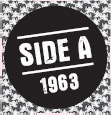
COME ON
Chuck Berry / 1:50
SINGLE
Come On / I Want to Be Loved
RELEASE DATE
United Kingdom: June 7, 1963
Label: Decca
RECORD NUMBER: F 11675
Musicians
Mick Jagger: vocals
Keith Richards: rhythm guitar
Brian Jones: harmonica, backing vocals
Bill Wyman: bass, backing vocals (?)
Charlie Watts: drums
Recorded
Olympic Sound Studios, Carlton Street, London: May 10, 1963
Technical Team
Producers: Andrew Oldham, Eric Easton
Sound Engineer: Roger Savage
Genesis
In early May 1963, Eric Easton and Andrew Oldham reached an agreement with Brian Jones, as leader of the group, for a three-year management contract. On May 10, the London gang entered Olympic Sound Studios in Carlton Street, at the heart of the capital’s West End, for their first official recording session. Oldham had had the studio booked since May 2: £40 for three short hours. The sound engineer, Roger Savage, would retain a memory of having worked free of charge, although he was actually paid £5 per hour: “I agreed to record them one night without payment, because he didn’t have any money, so we sorta crept into Olympic late one night.… We set up and did four songs quite quickly.”5 A number of songs were thus recorded on May 10. In her book about Brian Jones, the journalist Laura Jackson10 mentions a superb version of “Dust My Blues” (by Elmore James), with Brian Jones on slide guitar. But the number chosen as the A-side for this first single was “Come On.”
“Come On” is a Chuck Berry song that was released by the rock ’n’ roll pioneer in October 1961 but failed to chart (unlike the B-side, “Go Go Go,” which climbed to number 38). Everything is wrong since me and my baby parted, sings Mick Jagger. This is a world away from the dark and brooding image the Rolling Stones had already started to cultivate, and equally far removed from the low-down blues, the “music of the devil” they had been voraciously imbibing since first setting foot in the clubs of Soho.
Why “Come On,” then? By all accounts, because this song had the potential to hook the widest possible audience. “The idea was Andrew’s—to get a strong single so they’d let us make an album, which back then was a privilege,”11 confides Keith Richards. One thing is certain: Jagger and the other members of the group have always hated this song, and it was under duress that they performed it (lip-synching) on the occasion of their first appearance on the television show Thank Your Lucky Stars (what’s more, dressed in black-and-white houndstooth jackets with a black velvet collar) on July 7, 1963. The Stones subsequently refused to include the number in their set list. When Oldham became aware of this at the Scene Club in Soho, he flew into a rage: “He went crazy when we didn’t play “Come On” and we had a row about it. He insisted we play it at every show.”1
Production
It is not difficult to see why the Stones did not particularly like their version of “Come On,” which they considered to be too pop. Compared to Chuck Berry’s version, it lacked groove and the group seems static, devoid of any sense of fun and indeed of any hint of their own real sound… Nevertheless, their cover has a certain charm. The framework is laid down by the Charlie Watts–Bill Wyman combination, with Wyman launching into the introduction with an excellent bass line, extremely precise and percussive, on his Dallas Tuxedo. Keith Richards provides a good rhythmic structure with ample reverb on his Harmony H70 Meteor. The sound and phrasing of Brian Jones’s contributions on his Hohner harmonica are reminiscent to a certain degree of John Lennon, and Mick Jagger delivers the lyrics with an assurance and a texture of voice ultimately not unlike those he still possesses today. His vocal is double-tracked by means of overdub, with backing vocals by Bill and Brian. Only Ian Stewart failed to perform on the song, acknowledging later that he didn’t play because he didn’t like the piece.
At the end of the May 10 session, John Savage turned to Andrew Oldham and asked him to do the mixing. Oldham, undergoing his baptism by fire as a producer, exclaimed: “I don’t know a damn thing about recording, or music for that matter.”12 It was therefore Savage who set to work. Listening to the band, Dick Rowe and various other managers at Decca, somewhat taken aback by the results, consulted on what was to be done. “Dick Rowe suggested to Eric [Easton] that the Stones go back into the studio with a ‘perhaps more qualified producer’”5 This was a slap in the face for the ambitious Oldham, then barely nineteen years old. The five Stones had to rerecord the whole thing, this time at Decca’s West Hampstead studios. This session is believed to have taken place on May 16 or 18. After the recording, Mick Jagger called Oldham and said: “It didn’t go well, in fact it’s worse than the Olympic session.” Rowe eventually decided to bring out the first version, thereby ratifying a recording contract with the Stones via Impact Sound.
The first Rolling Stones single hit the United Kingdom’s record stores on June 7, 1963. By July 31 it had reached the promising position of number 21 on the charts. So perhaps Oldham had been right after all.